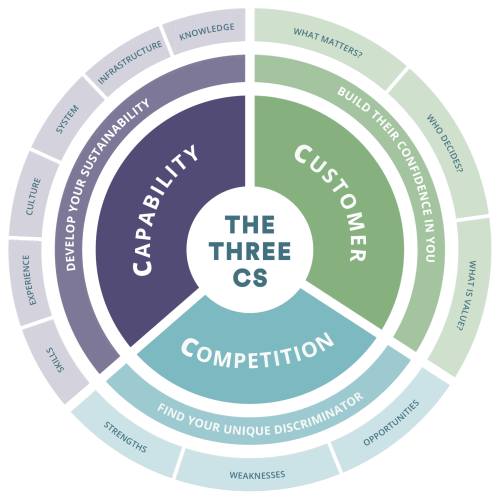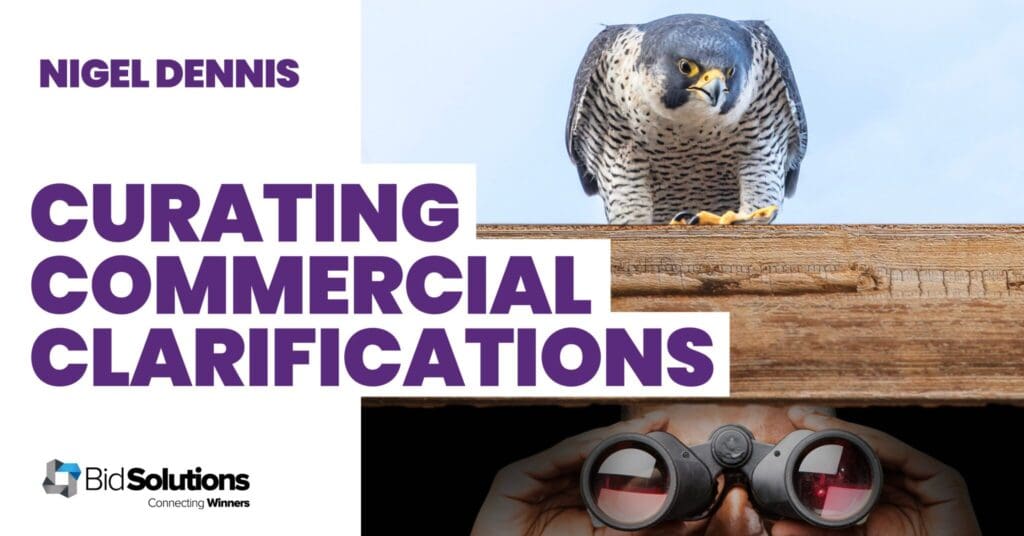Winning tendered contracts doesn’t happen by chance. Every successful bid is built on a solid foundation of insight, understanding and strategy. At BidWrite, one of the most important tools we use to lay this foundation is a framework called the Three Cs.
The Three Cs – Customer (or Client), Competition, and Capability – form a strategic framework used by tender and proposal professionals. The three Cs ensure all bidding activity aligns with customer needs, differentiates an organisation from its competitors, and demonstrates delivery capability.
Think of the Three Cs framework as a strategic lens. At BidWrite, we look at every stage of the bidding process through this lens. We apply it to your activity, decisions, solutions and submissions – continuously keeping your customer, competition and capability in focus.
Analysing the Three Cs can help with:
- pre-bid positioning – gathering insights and getting ahead before an RFT (Request for Tender) is released to market
- bid/no-bid decisions – providing meaningful analysis to inform your formal bid qualification process
- developing your ‘story to win’ – identifying key inputs to form strategic win themes
- kick-off meetings – ensuring all stakeholders are strategically aligned
- writing your tender response – contextualising questions in relation to customer, competition or capability.
Let’s take a closer look at what each of the Three Cs mean and how you can use them.
1. Customer (or client)
Build their confidence in you
Bidding is not about you – it’s about the buyer. Before you can write any truly customer-centric proposal, you first need to understand your customer’s business and how it operates. Find out:
- What really matters to them? What are their real pain points? What issues are they trying to solve? What do they require your solution to do?
- Who makes the decision? Is it a panel? A single procurement officer? Are there people with greater influence? Do they have biases, preferences or other agendas?
- How do they define value? Are they seeking the lowest upfront cost, the best long-term total costs, or the fastest solution? How do they measure return on investment?
These insights will help you influence your customer at all stages of the business development lifecycle. Before an RFT is released, they can help you position your organisation favourably with a potential buyer. And when their tender opportunity lands, these same insights will help you tailor win themes to align with what that specific buyer values.
Showing you understand your customer will build their confidence that you’re the right choice for their tendered contract.
2. Competition
Find your unique discriminator
Bidding is competitive. Before you run the race, analyse your competitors. This helps you understand what kind of race you’re in – and how to compete. Ask yourself:
- Who else is likely to bid in your industry?
- What are their known strengths or weaknesses?
- What opportunities are there to ensure your offer outshines theirs?
Analysing your competition is an opportunity to identify what makes your organisation unique. But simply being different is not enough. Your unique discriminator needs to provide a competitive advantage that actually matters to your customer.
If you’re not sure where to start, Nancy Lublin’s book ‘Zilch’ outlines five clear, quantifiable competitive advantages. At BidWrite, we remember these powerful differentiators by the acronym FOFBC. Are you the:
- First
- Only
- Faster
- Better
- Cheaper
…provider of your products/services?
Finding your unique discriminator sets your organisation apart from the competition – and makes your proposed solution stand out from other offers.
3. Capability
Develop your sustainability
Every bid that’s won will need to be delivered. But the third C is about much more than your organisation’s capability to deliver a single contract. It’s also about looking ahead to lay the groundwork for a strong, sustainable business relationship. Developing sustainable capability helps create successful long-term relationships between suppliers and buyers.
To analyse your capability, think about the following:
- The skills and qualifications of your team
- Relevant experience with similar clients, industries or projects
- Your company culture, especially where it aligns with the customer’s values
- Systems and processes that ensure consistency and quality
- Infrastructure and facilities that support service delivery
- Your knowledge of the industry and your solution.
Have you got enough of these to deliver what your customer needs – both now and in future? If not, what can you do to develop them? And if so, how will you prove it? Using examples, evidence, and credentials will make your capability known to evaluators.
Showcasing capability is a key requirement of almost every bid. So strong bidding capability is also essential to persuade buyers that your organisation is not just a provider, but a capable and sustainable partner.

Using the Three Cs – before a bid
Exploring the Three Cs before a bid enables you to better focus your efforts on tenders you’re likely to win. So before jumping to respond to the latest RFT, pause and use this strategic lens to assess the opportunity. Ask yourself:
- Do I truly understand the customer?
- Am I clearly positioned against the competition?
- Does my organisation have the capability to deliver?
If your answer to any of these is ‘no’, you may not be in the best position to win. At this point, it’s worth using a formal bid/no-bid decision process to guide your next step. This will likely confirm it’s best to qualify out the opportunity in question (and ideally send a polite no-bid letter).
In this case, the Three Cs have acted as a valuable gap analysis – highlighting areas to improve. Use this insight to start your pre-bid positioning work: understanding your customer, differentiating from your competitors, and building sustainable capability. With the Three Cs as your lens, you’ll soon be better positioned to identify and pursue aligned opportunities that come your way.
Alternatively, if you answered ‘yes’ to all three questions, you’re in a good position to pursue the tender opportunities on your radar.
But your work with the Three Cs doesn’t stop there!
Using the Three Cs – building your story to win
After qualifying in an opportunity, use the bid kick-off meeting to further explore the Three Cs with key stakeholders. Analysing your customer, competition and capability in relation to this specific opportunity will uncover the key themes that form your win strategy – or ‘story to win’.
You can then weave this narrative through various sections of your response. This can include your cover letter, executive summary, and answers to qualitative questions. This will show evaluators:
- you understand your customer’s needs and goals
- you offer a unique competitive advantage that they value
- you have the capability to deliver outcomes sustainably.
Look closely at the RFT through this lens and you’ll find that almost every question relates – either directly or indirectly – to one (or more) of the Three Cs. So using them to build a clear, compelling story to win, reiterated throughout your response, is sure to improve your chance of success.
Seeing bidding through our strategic lens
The Three Cs aren’t a one-time administrative ‘checklist’ for bidding. They’re a strategic lens through which we view the entire bidding process. Whether you’re positioning early, qualifying an opportunity, shaping win themes or finalising your response, this lens brings clarity, consistency and intent.
By keeping your customer, competition and capability in view, you’ll submit a focused, strategic bid – which can make all the difference when it comes to winning.
Need help crafting your next story to win? At BidWrite, we specialise in strategic tendering, tailored to your organisation and opportunity. Whether you need support with positioning, writing or production, we’re here to help. Get in touch >
FAQs
Here are some common questions about the Three Cs framework.
A: The Three Cs stand for Customer (or Client), Competition, and Capability. When considered together, they form a strategic framework used by bid and proposal professionals to ensure bidding activity and tender responses align with customer needs, differentiate an organisation from its competitors, and demonstrate delivery capability.
A: BidWrite suggests thinking of the Three Cs framework as a strategic lens through which you view all bidding activity. Keep your customer, competition and capability in mind at every stage of the bidding process. This includes using the Three Cs during pre-bid positioning, bid/no-bid decisions, at kick-off meetings, developing your ‘story to win’ or strategic win themes, and when writing your tender response.
A: Applying the Three Cs across your positioning, planning, and submission enables you to bid more strategically. The framework helps you position early, focus your efforts, align with customer needs, stand out from competitors, and ensure delivery capability. Together, these strategic improvements lead to more effective bidding – boosting your chances of success.
A: The Three Cs don’t replace a formal go/no-go framework like BidWrite’s. But they do provide valuable insight to inform it. By assessing what you know about the customer, how you compare to the competition and whether you have the capability to deliver, you can feed meaningful analysis into your decision-making process – helping you qualify opportunities in or out more effectively.
A: Start by applying the Three Cs lens to your own bids and identifying any gaps. To deepen your knowledge, explore BidWrite’s Bid Academy. The framework is introduced in our Bid Basics short course and covered in more detail in the Bid Accelerator and Certified Bid Writer programs, where you’ll learn to apply it in real-world scenarios. You can also learn more through BidWrite’s bid support consulting services.



